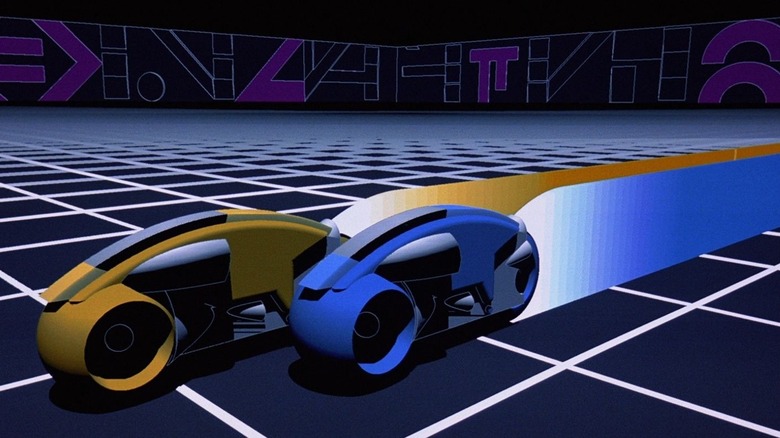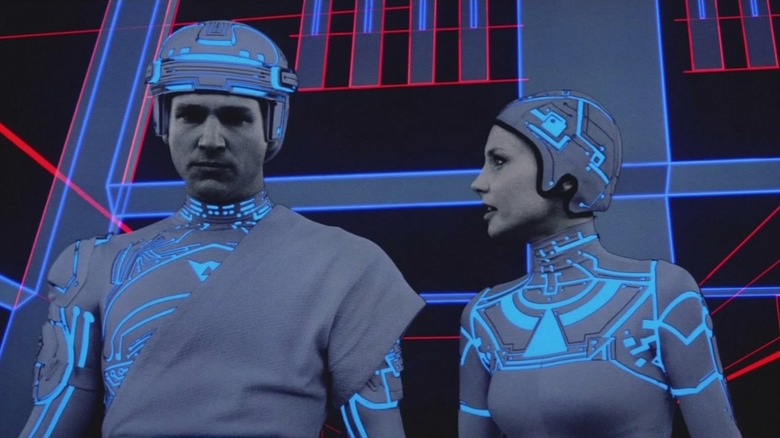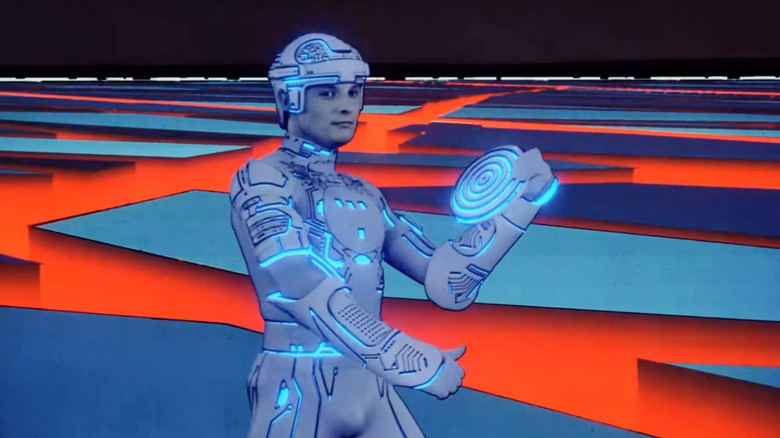TRON's Innovative Computer Animation Still Required Graph Paper, Math, And A Prayer
Steven Lisberger's 1982 sci-fi film "Tron" was a special effects bonanza that was disqualified for the Best Visual Effects Oscar the year it came out, as the Academy felt that employing computers to animate film visuals was "cheating." "Tron" famously used extensive CGI, making it the first major feature film to use computers as extensively as it did. The film is about a human computer programmer (Jeff Bridges) who is dematerialized by a malevolent, intelligent computer program, and rematerialized inside a computer mainframe.
Inside the mainframe, computer programs are human-shaped beings that must compete in blood sports, aka video games, at the behest of their "Users," spoken of like deities. Tron (Bruce Boxleitner) is a dashing heroic program who aims to confront the tyrannical Master Control Program, and Jeff Bridges joins Tron to help.
The computer "interiors" were envisioned as a vast, black space, populated by glowing towers and spires constructed of gently glowing wire frames. The human actors were filmed in a way-too-complicated process wherein they would be filmed in black-and-white, and then the film strip would be laid over, copied, laid over again, and processed multiple times, just to insert every last visual element into a frame. This had to be done because there was no way to extract CGI backgrounds from a computer and put them on a filmstrip, making composing actors onto CGI backgrounds nearly impossible.
The inability to extract CGI from a computer also required a lot of analog handiwork from the VFX technicians, even for the CGI scenes with no actors in them (like the lightcycle sequence in the picture above). Animator Bill Kroyer talked to the Guardian in 2023, and he revealed the complex graph paper-based mapping system his technicians needed to employ to get the visuals on film.
Graphing the CGI in TRON
Back in the early 1980s, rendering CGI models in a computer was a much longer and more arduous process and, as one can see from "Tron," produced relatively rudimentary visuals. The CGI images were constructed of clear polygons, and each object had to be rendered from multiple angles for every single frame of film. Then, once a visual was rendered, a camera had to photograph the computer screen (!), clicking each fully rendered image, laying them out one frame at a time. In many ways, this was carried out very much the same way one might make traditional cel animation. Instead of photographing a hand-painted image, however, it was the in-computer rendering.
When animating one frame at a time, however, one needed to be very, very meticulous about how those images needed to be laid out. Bill Kroyer was the head of computer animation on "Tron," and he said the animation process involved a lot of geometry. Animators had to calculate out the actual 3D space before drawing out where a lightcycle might be in it, and nail the angles exactly. "We had to figure out how to position and render objects 24 times to make one second of perceived movement on the screen," Kroyer said.
Once the animators calculated the angles and drew out the CGI images on paper, computer engineers would then come in an input all the calculations into their computer. A single image would presumably appear, and a camera could photograph it. A full sequence wouldn't emerge until all the images were photographed and strung together, printed on a 35mm filmstrip, and projected. Only then would the filmmakers see how it looked.
Dang, was Tron ever complicated
"Tron," it should be noted, bombed when it was first released. It had a budget of a then-whopping $17 million, and earned only $4 million on its opening weekend. It would eventually go on to make about $33 million worldwide, making it only a modest success. Critics were split on its bizarre visuals, with some liking the odd, computerized designs, and others feeling them to be "loud, bright, and empty." Disney licensed a tie-in arcade cabinet, and the game was more successful than the film itself. To this day, there is some debate among critics and cineastes if "Tron" looks good or bad. Is it unique and technologically forward, or was the extra effort for naught if the film flopped?
Over the years, however, youngsters gathered around "Tron" having seen it on home video and becoming attached to its weird, ambitious CGI visuals, still novel at the time. Thanks to the nostalgia economy, a sequel to "Tron," called "Tron: Legacy" was released in 2010. A third film, "Tron: Ares," is due in theaters on October 10, 2025.
One might be able to say in 2024 that all the work that went into making the "Tron" special effects was worth it, but for many years, it was seen as a waste. Making multiple photographic passes on each in-computer frame was a massive headache, and some sequences require fifty photographic components pressed down into a single frame. This was paired with the complex graph paper animation required to render the CGI sequences. The whole film only runs 96 minutes, and some might wonder why the filmmakers didn't merely construct illuminated sets and film actors in front of them. It would have saved time and effort.


